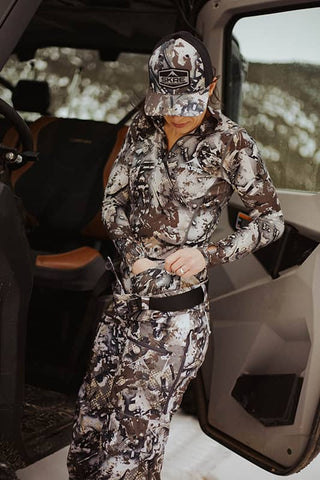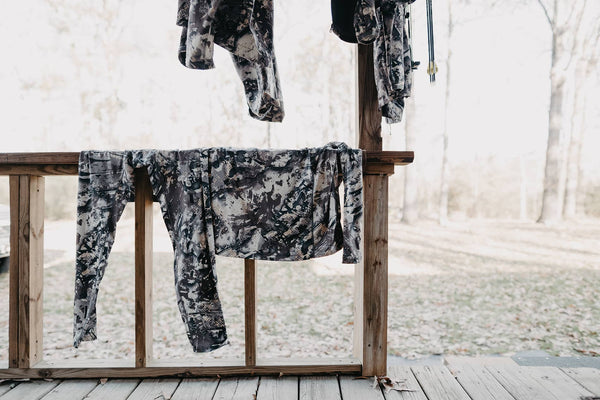How Should a Base Layer Fit?
Mar 09, 2023
With over 15 million Americans holding hunting licenses in 2021, getting the right gear is paramount. While camouflaged jackets and big, burly boots all make the hunting experience more enjoyable, nothing matters as much as finding the right base layer. But how should a base layer fit?
Base layers keep your temperature moderated and allow you freedom of movement. When you're covered head-to-toe in heavy gear, you'll appreciate the right base layer.
Let's take a look at some of the best base layer types and how they should fit.
Base Layers Designed For Function And Comfort
An essential part of any layering system is a high quality base layer. SKRE Gear® offers a variety of base layers to choose from to help you stay comfortable during the entirety of your hunt.
Shop All Base Layers
How Should a Base Layer Fit?
Before buying a base layer, consider how tight it will feel during a hunt. Because you want it to keep you warm without being restrictive, getting the perfect fit and type should be your top priority.

Should a Base Layer Be Tighter on Specific Body Parts?
Not necessarily, however, it should be tight wherever you wear a base layer. This includes your feet, torso, and lower limbs. This not only ensures temp regulation but also allows for more freedom of movement.
For example, your torso must be warm because it contains so many of your most important organs. If your torso temperature is too cold, your heart may not function properly and you risk poor circulation to areas like your fingertips and toes.
Similarly, you must ensure you have a tight base layer around your legs. Your legs and feet are one of the most difficult circulatory areas because your heart has to pump blood down and up. By having a tight base layer in this area, you'll be noticeably warmer.
However, this is not to say your base layer should be restrictively tight. This can have the opposite effect and will cut off your circulation and affect your range of motion.
How Stretchy Should a Base Layer Be?
Base layer stretchiness is simply a matter of personal preference. A stretchier base layer will allow you more freedom and flexibility. However, it may compromise heat-loss prevention if it is too stretchy.
Base layers should offer some give as they must fit a wide range of body types. When trying on your base layers, always ensure to move around and bend so you can check just how stretchy they are.
Certain materials, such as elastics, enhance the ability of base layer stretchiness. Generally, stretchy materials are blended with polyester to offer optimal warmth and a range of flexibility.
How to Know if Your Base Layer Is Too Tight?
As well as a noticeable cut-off in circulation, there are a few ways to tell if your base layer is too tight. First and foremost, it will be uncomfortable. You'll have less freedom to move and may find some movements more uncomfortable.
A second way to tell is to note how the layer is moving on your body. Does it ride up? Or is it very difficult to remove after sweat-breaking exercise?
Finally, if you notice any redness, blistering, or sores after wearing your base layer, it may be too tight. These skin issues will be caused by excess friction as a result of a clingy base layer. Treat with the right ointment or cream and ensure you get a new base layer that's not as tight.
What's the Best Way to Choose the Right Size?
If you can, always try on your base layers before you buy. This is the best way to ensure they fit the way you want them to and don't cling or rise.
If trying on isn't possible (e.g., if you're buying online or it goes against the store's hygiene policy), make sure you consult the store's size guide. Go in knowing your height and other measurements so that you can make an informed estimate regarding what size will fit you best.
Always trust your instinct when it comes to buying base layers. If you know that you usually run a size smaller when it comes to tighter clothing, then you'll know a smaller size will probably suit your base layer. Sizing is exceptionally important to ensure you get the most out of the base layer you choose.
Something to keep in mind is that if you are shopping for base layers from Skre, they offer a VIP sizing guarantee, so you are sure to get the right fit!
What Are the Different Types?
There are base layer options for almost every part of your body. Base layer underwear, socks, vests, and tight bottoms are all available in a wide range of sizes and for every gender. But are they all necessary?
The answer depends on what you're doing and when you're doing it. For example, if you decide to go on a winter hunt, you'll likely want to have as many base layers as you can carry. You'll be facing freezing elements and tricky terrain, so you want to ensure you stay as warm as possible.
One base layer material option that is a great fit and allows you a full range of motion is Merino wool. It should be worn tight against your skin as this offers the most insulation possible. You may want to pair Merino wool layers with more stretchy materials to enhance flexibility.
What to Consider Before Buying a Base Layer?
When it comes to buying a new base layer, don't just go with the first piece you try on. You need to think carefully about how it will affect the following aspects of your chosen sport.

Your Ability to Move
While the base layer you choose should be stretchy to fit your body type, you need to be able to move well in it. You'll want to be able to stretch, bend, and stay in unusual positions for a long time.
Now, if you're hunting, you might think movement isn't all that important considering you could have to stay still for long periods. However, if you need to move to a different angle or stretch a little more freely on the forest floor, you don't want your base layer to snag or hinder you.
That's why it's so important that your base layers align seamlessly with your body. You'll be warm, have the best possible circulation, and be able to move easily while still feeling snug and protected.
How Will It Affect Your Performance?
A base layer is good for more than just keeping you warm. It offers a protective layer in harsh weather so that you can continue your chosen sport without any problems. In doing so, you can stay outside for longer, thereby improving your performance.
If you're competing or training, you want to be able to stay active for as long as you can. A proper insulating base layer allows you to do this as you'll conserve vital energy.
This is especially necessary for the winter when the weather may be at its most extreme. You'll experience less damage from cold temperatures and acclimatize to inside warmth much more quickly when you get back home.
Is It Comfortable?
When it comes to any kind of sporting clothes, comfort is one of the most important factors. Even if you're dry and warm, if your base layer is itchy, scratchy, or simply feels awkward, that's all you'll be able to focus on.
An uncomfortable base layer will impact your performance and your movement. Always check that the fabric used in your base layers is comfortable and that you don't have any allergies to it. Ensuring you select the right-sized base layer will also go a long way in keeping you comfortable.
Base Layers Designed For Function And Comfort
An essential part of any layering system is a high quality base layer. SKRE Gear® offers a variety of base layers to choose from to help you stay comfortable during the entirety of your hunt.
Shop All Base Layers
What Are the Main Types of Base Layer Fit?
There are several types of base layer fits that offer specific benefits. Because base layers are not just for the winter, certain fits may work better at particular times of the year. Or you may find a fit you love and choose to stick with it year-round!

Relaxed
Some base layers fit the body more loosely and provide a more comfortable fit. You might think you'll miss out on important temperature control with relaxed base layers, but as long as they are comfortable and fit you properly, they'll still keep you warm.
A more relaxed base layer of clothing could cause a rippling effect, and create wrinkles that give the body a more "laidback" fit. These are frequently found in tank tops that can be worn as external or base layer clothing.
Pure Merino wool clothes with vertical fabric weaves hang more loosely, so they also offer a relaxed fit while still providing powerful insulation. One of the many advantages of relaxed-fitting base layers is that they can be worn over other layers to add additional protection and insulation.
Soft Fit
Soft fit covers a range of base layer options that are comfy, padded, or cushioned. These kinds of base layers are often made using increased-density Merino wool. This provides them with a forgiving fit that offers maximum stretch.
The ultimate soft fit base layer is a body-contoured garment that fits comfortably and coolly. It should be able to cool and heat as you need. It shouldn't feel tight in any way.
It is frequently preferable to wear quality leisure clothing underneath regular clothing for all-day comfort. That way, whether you're hunting, hiking, or biking you'll have a protective thermal layer that doesn't cause friction or excess sweat.
Compression
Compression-fit base layers squeeze the body resulting in a rigid fit. Don't mistake this for meaning they're too tight. Compression clothing is highly beneficial for the body.
It improves circulation as a whole, and many notice how much more awake they feel thanks to this improved circulation. Compression base layers can also keep you calmer in physically intense situations as they encourage a more regular heartbeat.
There are three main types of the compression fit. They are:
- level 1
- level 2
- level 3
A level 1 compression fit gives an entire body squeeze and sits tightly on the skin. Level 2 is used to improve circulation and is often worn by professional athletes. Level 3 is used for anyone recovering from an injury.
Fitted
The easiest way to describe a fitted or semi-fitted base layer is as a base layer without excess compression. These kinds of base layers are often used by those seeking a little extra insulation.
If you have chosen to wear a fitted base layer, you should avoid stretching it out too much. After all, it isn't designed to provide the relaxed feel of a soft base layer. You want to keep fitted layers tight so that they help keep you warmer.
However, fitted base layers aren't so tight that they feel uncomfortable. They fit seamlessly into the natural contours and bends of your body, offering you a wider range of movement. They also protect against sweat, blistering, and friction.
Unlike compression base layers, fitted bases don't actively improve circulation. However, they certainly won't cut blood flow off. They are simply designed to control your temperature, so are ideal for colder outdoor conditions.
Are There Different Weight Options?
Specially designed base layers come in various weight options. You should choose which weight option to go for based on the exercise or sport you are doing. You should also take into consideration how comfortable the weight will be, what else you will be carrying, and if the base layer can still provide you with the ample movement you need.
Lightweight
Lightweight base layers are very thin and lie as close to the skin as possible. Ideal for those who wish to minimize bulk, they work well for sports like hunting where heavy gear needs to be carried.
Midweight
As you might have guessed, midweight base layers provide a medium warmth level. They work best for times when the temperature is chilly but not quite freezing. They're great for those who won't be out in the cold for too long, but wish to stay warm while outside.
Heavyweight
Heavyweight base layers are usually thick and offer the most insulation. You might notice that they add extra weight because they are designed to provide you with maximum heat and reduce any chance of warmth escaping.
Base Layer Options
Finally, there are various clothing options you should consider when buying your base layer. Take into account what you will be wearing on top of your base layer before buying, as this will affect your movement, performance, and how comfortable you are.
Long Sleeved Tops

If your torso and arms are your main concern when it comes to protection, a long-sleeved top is a great option for a base layer. Beginning at your neck and ending at your wrists and just above your hips, long-sleeved top base layers work to keep your heart, lungs, and stomach warm.
Depending on the type of fit, long-sleeved top base layers can help to promote circulation in your arms and hands. This is crucial if you’re doing an exercise that requires substantial arm strength, like hunting or climbing.
However, you must get the right-sized long-sleeve base layer. Otherwise, it could bunch up uncomfortably at the wrists. It could also ride up on your torso, and you may need to dig under your other layers to fix it.
Short-Sleeved Tops
A short-sleeved top base layer offers many of the same advantages as a long-sleeved one. However, it will allow you to move your arms more freely. It may suit people who enjoy running, as they can swing their arms while still maintaining a healthy body temperature.
A short-sleeved base layer also looks chic and flattering as a stand-alone t-shirt. You can wear it to the gym to help get your blood pumping while you work out.
These kinds of base layers won’t ride up at the sleeves, making them a very comfortable choice. Still, it’s important to get them in the right size and fit for you.
Underwear
It may seem like overkill to wear base-layer underwear. However, the right kind of underwear can make a serious difference to your performance.
You can choose between long or short base layer underwear. Both will keep you warm and offer protection against sweat and friction.
Base layer underwear comes in the same kind of fit as other types. You’ll want to avoid anything too tight or underwear that could bunch up, so make sure you select the right size.
Base layer underwear tends to sit very snugly against your skin, so you may not find padded or cushioned types as easily. You can add extra layers by doubling up on underwear or wearing shorts.

Long Legged Bottoms
Long-legged base layer bottoms start at your hips or waist and end at your ankles. They are designed to offer protection, warmth, and compression to your legs. In doing so, they enable you to exercise for longer.
Thermal long-legged base layers are ideal for camping trips or prolonged outdoor activities. If your legs get cold, you’ll struggle to maintain your balance and move efficiently. By enhancing the blood flow to your legs, long-legged base layers keep the muscles healthy and ready for anything.
3/4 Length Bottoms
Like long-legged base layer bottoms, ¾ length bottoms keep your lower limbs warm and healthy. However, these kinds of bottoms only go as low as your calves.
They are ideal for those less focused on temperature regulation and more focused on increased blood flow. If you wear shorts during your chosen exercise, ¾ length layer can sit comfortably under them.
Like base layer underwear, ¾ length bottoms act as a kind of second skin. They offer serious flexibility so you can stretch and bend as you need to.
One-Piece Base Layer
A one is one of the best kinds of base layer options. One-piece base layers begin at the base of your neck and generally go straight to your ankles and wrists. However, some also cover your feet and hands.
A one-piece offers the most convenience of all the base layers you can choose from. It provides warmth to every part of your body so you don’t have to ever worry about being cold. You can even double it up with other base layer options for additional insulation.
One-piece base layers are available in all the fit types listed above. They come in a wide range of materials, with some offering additional stretch and flexibility. Others provide excellent cushioning, particularly those made from Merino wool.
A further advantage of one-piece base layers is that they shouldn’t ride up. Regardless of the kind of movement you’re doing while wearing your one-piece base layer, it will stay tight against your skin.
Don't Let Base Layer Discomfort Throw You Off Your Game
Getting the right base layer will improve your hunting experience overall. By allowing for increased flexibility, compression, and temperature control, you'll be more focused on your game and less focused on your body. So, how should a base layer fit?
It all depends on what you're trying to achieve. A relaxed fit might allow you a little more movement, while a compression fit will lock in heat. As long as you're comfortable and warm, and your base layers fit you well, there's no wrong choice!
If you are looking for high quality base layers for your next outdoor adventure, make sure to check out Skre's full lineup of base layer products. Not only are they comfortable and built to perform, but they are durable, so you can continue using them for years to come!



